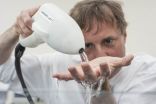(Press-News.org) Amsterdam, September 16, 2015 - Targeted cancer treatments, toxicity sensors and living factories: synthetic biology has the potential to revolutionize science and medicine. But before the technology is ready for real-world applications, more attention needs to be paid to its safety and stability, say experts in a review article published in Current Opinion in Chemical Biology.
Synthetic biology involves engineering microbes like bacteria to program them to behave in certain ways. For example, bacteria can be engineered to glow when they detect certain molecules, and can be turned into tiny factories to produce chemicals.
Synthetic biology has now reached a stage where it's ready to move out of the lab and into the real world, to be used in patients and in the field. According to Professor Pamela Silver, one of the authors of the article from Harvard Medical School in the US, this move means researchers should increase focus on the safety of engineered microbes in biological systems like the human body.
"Historically, molecular biologists engineered microbes as industrial organisms to produce different molecules," said Professor Silver. "The more we discovered about microbes, the easier it was to program them. We've now reached a very exciting phase in synthetic biology where we're ready to apply what we've developed in the real world, and this is where safety is vital."
Microbes have an impact on health; the way they interact with animals is being ever more revealed by microbiome research - studies on all the microbes that live in the body - and this is making them easier and faster to engineer. Scientists are now able to synthesize whole genomes, making it technically possible to build a microbe from scratch.
"Ultimately, this is the future - this will be the way we program microbes and other cell types," said Dr. Silver. "Microbes have small genomes, so they're not too complex to build from scratch. That gives us huge opportunities to design them to do specific jobs, and we can also program in safety mechanisms."
One of the big safety issues associated with engineering microbial genomes is the transfer of their genes to wild microbes. Microbes are able to transfer segments of their DNA during reproduction, which leads to genetic evolution. One key challenge associated with synthetic biology is preventing this transfer between the engineered genome and wild microbial genomes.
There are already several levels of safety infrastructure in place to ensure no unethical research is done, and the kinds of organisms that are allowed in laboratories. The focus now, according to Dr. Silver, is on technology to ensure safety. When scientists build synthetic microbes, they can program in mechanisms called kill switches that cause the microbes to self-destruct if their environment changes in certain ways.
Microbial sensors and drug delivery systems can be shown to work in the lab, but researchers are not yet sure how they will function in a human body or a large-scale bioreactor. Engineered organisms have huge potential, but they will only be useful if proven to be reliable, predictable, and cost effective. Today, engineered bacteria are already in clinical trials for cancer, and this is just the beginning, says Dr. Silver.
"The rate at which this field is moving forward is incredible. I don't know what happened - maybe it's the media coverage, maybe the charisma - but we're on the verge of something very exciting. Once we've figured out how to make genomes more quickly and easily, synthetic biology will change the way we work as researchers, and even the way we treat diseases."
INFORMATION:
Read the story on Elsevier Connect
Article details
"Synthetic biology expands chemical control of microorganisms" by Tyler J Ford and Pamela A Silver (doi: 10.1016/j.cbpa.2015.05.012). The article appears in Current Opinion in Chemical Biology, Volume 28 (October 2015), published by Elsevier.
A copy of the paper is available to credentialed journalists upon request, contact Elsevier's Newsroom at newsroom@elsevier.com or +31 20 4853564.
About Current Opinion in Chemical Biology
Current Opinion in Chemical Biology provides systematic information on the views of experts on current advances in chemical biology in a clear and readable form, and evaluations of the most interesting papers, annotated by experts, from the great wealth of original publications. The subject of chemical biology is divided into themed sections which are reviewed regularly to keep them relevant. For 2015 they include Next Generation Therapeutics, Synthetic Biology and Omics. http://www.journals.elsevier.com/current-opinion-in-chemical-biology
About Elsevier
Elsevier is a world-leading provider of information solutions that enhance the performance of science, health, and technology professionals, empowering them to make better decisions, deliver better care, and sometimes make groundbreaking discoveries that advance the boundaries of knowledge and human progress. Elsevier provides web-based, digital solutions -- among them ScienceDirect, Scopus, Elsevier Research Intelligence and ClinicalKey -- and publishes over 2,500 journals, including The Lancet and Cell, and more than 33,000 book titles, including a number of iconic reference works. Elsevier is part of RELX Group plc, a world-leading provider of information solutions for professional customers across industries.
http://www.elsevier.com
Washington -- A new analysis by the Synthetic Biology Project at the Wilson Center finds the Defense Department and its Defense Advanced Research Projects Agency (DARPA) funds much of the U.S. government's research in synthetic biology, with less than 1 percent of total federal funding going to risk research.
The report, U.S. Trends in Synthetic Biology Research, finds that between 2008 and 2014, the United States invested approximately $820 million dollars in synthetic biology research. In that time period, the Defense Department became a key funder of synthetic biology ...
The first true three-dimensional picture of submarine canyon habitats has been produced using a unique combination of marine robotics and ship-based measurements. The information captured in this new set of maps ranges in scale from the 200km canyon down to the size of an individual cold-water coral polyp, and will be used to inform the management of the only English Marine Conservation Zone in deep water.
This 'nested map' is the result of a recent scientific expedition to the Whittard Canyon in the Bay of Biscay, led by the National Oceanography Centre (NOC). It works ...
ROCHESTER, Minn. - Mayo Clinic researchers have identified a protein marker whose frequency may predict patient response to PD-1 blockade immunotherapy for melanoma. An abstract of their findings was presented today at the American Association for Cancer Research International Cancer Immunotherapy Conference in New York City.
"The discovery of biomarkers of sensitivity are vital not only for informing clinical decisions, but also to help identify which patients with melanoma, and possibly other malignancies, who are most likely to benefit from PD-1 blockade," says Roxana ...
The oil and gas extraction method called hydraulic fracturing remains controversial for multiple reasons, one of which is its water use. But, as scientists report in ACS' journal Environmental Science & Technology Letters, water requirements for the process are potentially lower than those for some other energy-related extraction methods.
Since oil and gas companies ramped up hydraulic fracturing, or fracking, to unlock oil and gas from shale and tight oil formations, reports of earthquakes and contaminated water near wells proliferated. Some environmental experts have ...
Detecting breast cancer in women with dense mammary tissues could become more reliable with a new mammogram procedure that researchers have now tested in pre-clinical studies of mice. In their report in the journal ACS Nano, they describe injecting gold nanoparticles in mammary tissue to enhance the imaging of early signs of breast cancer.
Mammography remains the clinical gold standard of screening tests for detecting breast cancer. However, a recognized limitation of this X-ray procedure is that dense breast tissue shows up as white masses and fibers on an image, ...
Citizen science is taking off and could make a difference at regional and national regulatory levels. But not everyone thinks that's a good idea. The cover story of Chemical & Engineering News (C&EN), the weekly newsmagazine of the American Chemical Society, delves into the progress of the budding movement, as well as the pushback.
Steven K. Gibb, senior editor at C&EN, reports that in some states, regulators actively encourage and support local residents' participation in environmental monitoring. For example, Maryland's Department of the Environment and Department ...
Fossils tell amazing stories and inspire them, too -- just think of this summer's "Jurassic World" blockbuster. But because some of the processes that preserve fossils are not well understood, there's still more information that they could reveal. Now scientists report in ACS' journal Analytical Chemistry a new way to probe fossils to find out how these ancient remains formed in greater detail than before.
When most organisms die, they biodegrade and leave little behind. But if they get trapped in sediments that harbor few bacteria and loads of dissolved minerals, they ...
Coughing. A sore throat. Maybe a pain in your chest as you take a deep breath.
These are all common symptoms for many city-living Australians when smog levels are high. And while it is well understood that smog can cause such problems, new research has for the first time given us a glimpse as to what might be happening at the molecular level.
The University of Melbourne's Professor Richard O'Hair, from the School of Chemistry's Bio21 Institute, in collaboration with Professor Stephen Blanksby (from the Queensland University of Technology and formerly the University ...
Researchers from the University of Southampton have demonstrated how a pioneering ultrasonic device can significantly improve the cleaning of medical instruments and reduce contamination and risk of infection.
StarStream, invented and patented by the University of Southampton and in commercial production by Ultrawave Ltd., makes water more efficient for cleaning by creating tiny bubbles which automatically scrub surfaces. The device supplies a gentle stream of water through a nozzle that generates ultrasound and bubbles, which dramatically improve the cleaning power of ...
This news release is available in German.
Platinum is a great catalyst and can be used for many different applications. It's expensive stuff though, so tiny platinum nanoparticles sitting on cheap metal oxide materials are used to convert harmful carbon monoxide into carbon dioxide. Using scanning tunnelling microscopes, scientists at TU Vienna have now been able to image the catalytic behaviour of platinum sitting on iron-oxide, which allowed them to explain the process on an atomic scale. Surprisingly, the chemical reactions do not take place on the platinum ...


